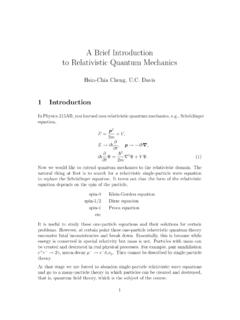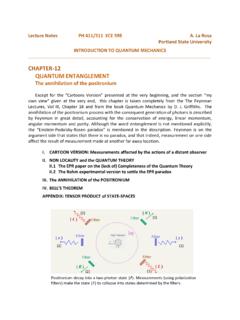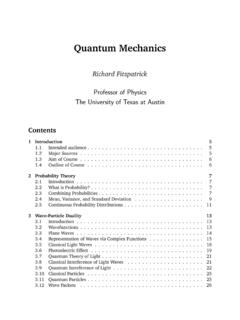Transcription of Indistinguishable particles in quantum mechanics: …
1 This article was downloaded by: [Louisiana State University]On: 22 March 2013, At: 15:12 Publisher: Taylor & FrancisInforma Ltd Registered in England and Wales Registered Number: 1072954 Registered office: Mortimer House,37-41 Mortimer Street, London W1T 3JH, UKContemporary PhysicsPublication details, including instructions for authors and subscription information: particles in quantum mechanics : anintroductionYasser Omar aa Departamento de Matem tica, ISEG, Universidade T cnica de Lisboa, P-1200-781, Lisbon,PortugalVersion of record first published: 20 Feb cite this article: Yasser Omar (2005): Indistinguishable particles in quantum mechanics : an introduction , ContemporaryPhysics, 46:6, 437-448To link to this article: SCROLL DOWN FOR ARTICLEFull terms and conditions of use: article may be used for research, teaching, and private study purposes. Any substantial or systematicreproduction, redistribution, reselling, loan, sub-licensing, systematic supply, or distribution in any form toanyone is expressly publisher does not give any warranty express or implied or make any representation that the contentswill be complete or accurate or up to date.
2 The accuracy of any instructions, formulae, and drug doses shouldbe independently verified with primary sources. The publisher shall not be liable for any loss, actions, claims,proceedings, demand, or costs or damages whatsoever or howsoever caused arising directly or indirectly inconnection with or arising out of the use of this particles in quantum mechanics : an introductionYASSER OMAR*Departamento de Matema tica, ISEG, Universidade Te cnica de Lisboa, P-1200-781 Lisbon, Portugal(Received 26 August 2004; in final form 16 September 2005)In this article, we discuss the identity and indistinguishability of quantum systems and theconsequent need to introduce an extra postulate in quantum mechanics to correctlydescribe situations involving Indistinguishable particles . This is, for electrons, the PauliExclusion Principle, or in general, the Symmetrization Postulate.
3 Then, we introducefermions and bosons and the distributions respectively describing their statisticalbehaviour in Indistinguishable situations. Following that, we discuss the spin-statisticsconnection, as well as alternative statistics and experimental evidence for all these results,including the use of bunching and antibunching of particles emerging from a beamsplitter as a signature for some bosonic or fermionic An extra postulate is requiredI believe most physicists would consider that the postulates(or at least the properties they embody) concerning thesuperposition, evolution and measurement of quantumstates cover the essence of quantum mechanics , the theorythat is at the basis of current fundamental Physics and givesus such an accurate description of Nature at the atomicscale. Yet, if the theory was only based on these postulates(or properties), its descriptive power would be almost zeroand its interest, if any, would be mainly mathematical.
4 Assoon as one wants to describe matter, one has to include anextra postulate:Pauli s Exclusion Principle. One of its usualformulations, equivalent to the one proposed originally byWolfang Pauli in 1925 [1], is the following:Pauli s Exclusion Principle No two electrons canshare the same quantum principle refers to electrons, which constitute asignificant (but not the whole) part of matter, and is crucialin helping us explain a wide range of phenomena, including:(a) the electronic structure of atoms and, as a conse-quence, the whole Periodic Table;(b) the electronic structure of solids and their electricaland thermal properties;(c) theformationofwhitedwarfs,wherethegravit ationalcollapse of the star is halted by the pressure resultingfrom its electrons being unable to occupy the samestates;(d) the repulsive force that is part of theionic bondofmolecules and puts a limit to how close the ions canget ( nm between Na and Cl7for solidsodium chloride), given the restrictions to the statesthe overlapping electrons can thus see how Pauli s insight when proposing theExclusion Principle was fundamental for the success ofQuantum mechanics .
5 Although he made many otherimportant contributions to Physics, it was for this one thathe was awarded the Nobel prize in , it is also interesting to note that thishappened before Samuel Goudsmit and Georg Uhlenbeckintroduced the idea ofelectron spin[2,3] later in 1925. In1913, Niels Bohr presented his model for the electronicstructure of the atom to explain the observed discreteenergy spectra of hydrogen and other elements [4]: theelectrons fly around the positive nucleus in circular orbits{*Corresponding author. Email: wrong idea, as we shall discuss Physics, Vol. 46, No. 6, November December 2005, 437 448 Contemporary PhysicsISSN 0010-7514 print/ISSN 1366-5812 online 2005 Taylor & : by [Louisiana State University] at 15:12 22 March 2013 with quantized angular momentum. This quantizationrestricts the possible orbits to a discrete set, eachcorresponding to an energy level of the atom.}
6 This modelwas then improved during the following decade, mainly byArnold Sommerfeld and Alfred Lande , rendering it moresophisticated, trying to make it able to account for themultiplet structure of spectral lines, including for atoms inelectric and magnetic fields. In 1922, Pauli joins the effort(actually, it was rather a competition) to find an explana-tion for the then-calledanomalous Zeeman effect, a splittingof spectral lines of an atom in a magnetic field that wasdifferent from the already known Zeeman splitting (see [5]for a technical historical account on this competition).Another puzzle at the time, identified by Bohr himself, wasthe following: how to explain that in an atom in the groundstate the electrons do not all populate the orbit closest tothe nucleus (corresponding to the lowest energy level) [6]?These two problems led Pauli to postulate, towards the endof 1924, a new property for the electron a two-valuednessnot describable classically [7] and soon after the Exclu-sion Principle [1] as fundamental rules for the classificationof spectral lines.
7 But Pauli did not present any model forthis extra degree of freedom of the electrons. A few monthslater, Goudsmit and Uhlenbeck introduced the idea of anintrinsic angular momentum of12 hfor the electron, findingnot only a definite explanation for theanomalousZeemaneffect, but also establishing since then a connection betweenspin and the Exclusion Principle, a connection whosedepth they could not s Exclusion Principle remains as a postulate, forPauli s own dissatisfaction, as he expressed in his Nobelprize acceptance lecture in 1946: Already in my original paper I stressed the circum-stance that I was unable to give a logical reason for theexclusion principle or to deduce it from more generalassumptions. I had always the feeling, and I still have ittoday, that this is a deficiency. [8]In any case, as inexplicable as it may be, Pauli s ExclusionPrinciple seems to beg for a generalization.
8 In fact, it wassoon realized that other particles apart from electrons sufferfrom the same inability to share a common quantum state( protons). More surprising was the indication thatsome particles seem to obey the exact opposite effect,being under certain circumstances forced to share acommon state, as for instance photons in the stimulatedemission phenomenon, thus calling for a much more drasticgeneralization of Pauli s Principle, as we shall Identity and indistinguishabilityWe saw that Pauli s Exclusion Principle intervenes in a widerange of phenomena, from the chemical bond in the salt onour table to the formation of stars in distant galaxies. Thisis because it applies to electrons and we consider allelectrons in the universe to beidentical,as well as any otherkind of quantum particles :Identical particles Two particles are said to beidentical if all their intrinsic properties ( mass,electrical charge, spin, colour.)
9 Are exactly , not only all electrons are identical, but also allpositrons, photons, protons, neutrons, up quarks, muonneutrinos, hydrogen atoms, etc. They each have the samedefining properties and behave the same way under theinteractions associated with those properties. This brings usto yet another purely quantum effect, that we have two completely identical classicalobjects, that we cannot differentiate in any way. Shouldwe give them arbitrary labels, we could always at least inprinciple keep track of which object is which by followingtheir we know that in quantummechanics we must abandon this classical concept. The bestinformation we can get about some particle s locationwithout measuring it (and thus disturbing it) is that is has acertain probability of being in a particular position in space,at a given moment in time. This information is contained inthe particle sspatial state,for instance given bycjiV Zcr;t rjid3r; 1 where the vectorsjri, each representing the state corre-sponding to a particular position of the particle in thethree-dimensional Euclidean space, constitute an orthonor-mal (continuous) basis of the Hilbert space associated withthe position degree of freedom.
10 The coefficientc(r,t), alsoknown as the particle swave function, contains theprobabilistic information about the location of the particle,the only information available to us prior to a measure-ment. The probability of finding the particle in positionr0at a timetis given byPr0;t r0jchiV 2 cr0;t jj2: 2 Note that there is usually a volumeVoutside whichc(r,t) quickly falls off to zero asymptotically. We associatethespreadof the wave function to this volumeV, which canevolve in time. Finally, recall that because of Heisenberg suncertainty relations we cannot simultaneously measure theparticle s position and its momentum with an arbitraryprecision (see, for instance, [9]).How can we then distinguish identical particles ? Theirpossibly different internal states are not a good criterion,438Y. OmarDownloaded by [Louisiana State University] at 15:12 22 March 2013 as the dynamics can in general affect the internal degreesof freedom of the particles .

![2 Introduction to Quantum Mechanics [8 lectures]](/cache/preview/e/6/f/8/e/2/9/8/thumb-e6f8e298944e077bc520facb1f806e08.jpg)







